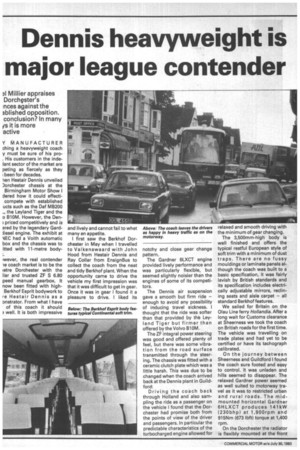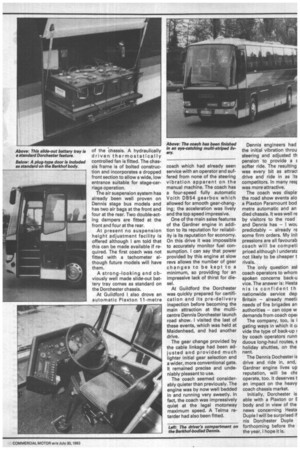Dennis heavyweight is major league contender
Page 34

Page 35

If you've noticed an error in this article please click here to report it so we can fix it.
Millier appraises Dorch9ster's nces against the ablished opposition. conclusion? In many ors it is more active
Y MANUFACTURER ching a heavyweight coach y must be sure of his pro. His customers in the indelant sector of the market are peting as fiercely as they been for decades.
ien Hestair Dennis unveiled )orchester chassis at the Birmingham Motor Show I dered how it could effecticorn pete with established ucts such as the Daf MB200 _, the Leyland Tiger and the o BlOM. However, the Den; priced competitively and is 5..‘red by the legendary Gardlies& engine. The exhibit at VEC had a Voith automatic box and the chassis was to itted with 11-metre body,.
wever, the real contender le coach market is to be the ietre Dorchester with the liar and trusted ZF S 6.80 peed manual gearbox. It now been fitted with highBerkhof Esprit bodywork to e e Hestair Dennis as a onstrator. From what I have of this coach it should well. It is both impressive and lively and cannot fail to whet many an appetite.
I first saw the Berkhof Dorchester in May when I travelled to Valkenswaard with John Hood from Hestair Dennis and Ray Collar from Ensigneus to collect the coach from the neat and tidy Berkhof plant. When the opportunity came to drive the vehicle my first impression was that it was difficult to get in gear. Once it was in gear I found it a pleasure to drive. I liked its notchy and close gear change pattern.
The Gardner 6LXCT engine provided lively performance and was particularly flexible, but seemed slightly noisier than the engines of some of its competitors.
The Dennis air suspension gave a smooth but firm ride — enough to avoid any possibility of inducing travel sickness. I thought that the ride was softer than that provided by the Leyland Tiger but firmer than offered by the Volvo BlOM.
The ZF integral power steering was good and offered plenty of feel, but there was some vibrati n from the road surface transmitted through the steering. The chassis was fitted with a ceramic clutch plate which was a little harsh. This was due to be changed when the coach arrived back at the Dennis plant in Guildford.
Driving the coach back through Holland and also sampling the ride as a passenger on the vehicle I found that the Dorchester had promise both from the points of view of the driver and passengers. In particular the predictable characteristics of the turbocharged engine allowed for relaxed and smooth driving with the minimum of gear changing.
The 3,500mm-high body is well finished and offers the typical restful European style of soft trim with a minimum of dust traps. There are no fussy mouldings or laminate panels although the coach was built to a basic specification, it was fairly lavish by British standards and its specification includes electrically adjustable mirrors, reclining seats and aisle carpet — all standard Berkhof features.
We sailed for Britain on the Olau Line ferry Holiandia. After a long wait for Customs clearance at Sheerness we took the coach on British roads for the first time. The vehicle was travelling on trade plates and had yet to be certified or have its tachograph calibrated.
On the journey between Sheerness and Guildford I found the coach sure footed and easy to control. It was unladen and hills seemed to disappear. The relaxed Gardner power seemed as well suited to motorway travel as it was to restricted urban and rural roads. The midmounted horizontal Gardner 6 HLXCT produces 1 4 lkW (230bhp) at 1,9 0Orpm and 915N m (673 I bft) torque at 1,400 rpm.
On the Dorchester the radiator is flexibly mounted at the front of the chassis. A hydraulically driven thermostatically controlled fan is fitted. The chassis frame is of bolted construction and incorporates a dropped front section to allow a wide, low entrance suitable for stage-carriage operation.
The air suspension system has already been well proven on Dennis stage bus models and has two air bags at the front and four at the rear. Two double-acting dampers are fitted at the front and four at the rear.
At present no suspension height adjustment facility is offered although I am told that this can be made available if required. The first coach was not fitted with a tachometer although future models will have them.
A strong-looking and obviously well made slide-out battery tray comes as standard on the Dorchester chassis.
At Guildford I also drove an automatic Plaxton 11-metre coach which had already seen service with an operator and suffered from none of the steering vibration apparent on the manual machine. The coach has a four-speed fully automatic Voith DB54 gearbox which allowed for smooth gear-changing; the acceleration was lively and the top speed impressive.
One of the main sales features of the Gardner engine in addition to its reputation for reliability is its reputation for economy. On this drive it was impossible to accurately monitor fuel consumption. I can say that power provided by this engine at slow revs allows the number of gear changes to be kept to a minimum, so providing for an impressive lack of thirst for diesel.
At Guildford the Dorchester was quickly prepared for certification and its pre-delivery inspection before becoming the main attraction at the multicentre Dennis Dorchester launch road show. I visited the last of these events, which was held at Maidenhead, and had another drive.
The gear change provided by the cable linkage had been adjusted and provided much lighter initial gear selection and a wider, more conventional gate. It remained precise and undeniably pleasant to use.
The coach seemed considerably quieter than previously. The engine was by now well bedded in and running very sweetly. In fact, the coach was impressively quiet at the legal motorway maximum speed. A Telma retarder had also been fitted.
Dennis engineers had the initial vibration throu steering and adjusted th pension to provide a E softer ride. The resulting was every bit as attract drive and ride in as :ts competitors. In many resr was more attractive.
The coach was displa the road show events alo a Plaxton Paramount bod metre automatic and an died chassis. It was well re by visitors to the road and Dennis has — I wou predictably — already re some firm orders. My ini1 pressions are all favourab coach will be competi priced although I understs not likely to be cheaper t rivals.
The only question asl coach operators to whom spoken concerns back-u vice. The answer is: Hesta nis is confident th nationwide service dep Britain — already meetil needs of fire brigades an authorities — can cope w demands from coach oper The company, too, is i gating ways in which it m vide the type of back-up r by coach operators runn duous long-haul routes, s holiday shuttles, on the nent.
The Dennis Dochester is drive and ride in, and, Gardner engine lives up reputation, will be chE operate, too. It deserves t an impact on the heavy coach chassis market.
Initially, Dorchester is able with a Plaxton or E body and in view of the news concerning Resta Duple I will be surprised if nis Dorchester Duple forthcoming before the the year. I hope it is.




















































































